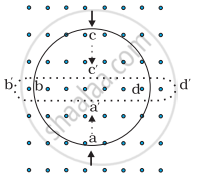Advertisements
Advertisements
प्रश्न
Two circular loops of equal radii are placed coaxially at some separation. The first is cut and a battery is inserted in between to drive a current in it. The current changes slightly because of the variation in resistance with temperature. During this period, the two loops _______________ .
पर्याय
attract each other
repel each other
do not exert any force on each other
attract or repel each other depending on the sense of the current
उत्तर
attract each other
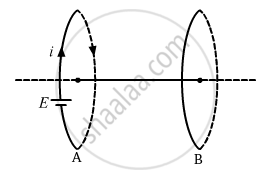
Consider loops A and B placed coaxially as above. Let the direction of the current in loop A be clockwise when a battery is connected to it. According to the right-hand screw rule, the direction of the magnetic field due to this current will be towards the left. Now, the current through this loop will decrease with time due to an increase in resistance with temperature. So, the magnetic field due to this current will also decrease with time. This changing current will induce a current in loop B. Now, according to Lenz's law, the direction of the induced current in loop B will be such that it will oppose the decrease in the magnetic field due to loop A. Hence, current will be induced in a clockwise direction in loop B. Also, because the direction of the currents in the loops is the same, they will attract each other.
APPEARS IN
संबंधित प्रश्न
Describe a simple experiment (or activity) to show that the polarity of emf induced in a coil is always such that it tends to produce a current which opposes the change of magnetic flux that produces it.
Predict the direction of induced current in the situation described by the following figure.

What is the direction of induced currents in metal rings 1 and 2 when current I in the wire is increasing steadily?

Show that Lenz's law is a consequence of conservation of energy.
Predict the directions of induced currents in metal rings 1 and 2 lying in the same plane where current I in the wire is increasing steadily.
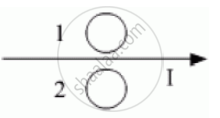
Predict the direction of induced current in metal rings 1 and 2 when current I in the wire is steadily decreasing?
A short magnet is moved along the axis of a conducting loop. Show that the loop repels the magnet if the magnet is approaching the loop and attracts the magnet if it is going away from the loop.
A bar magnet is released from rest along the axis of a very long, vertical copper tube. After some time the magnet ____________ .
A bar magnet is moved along the axis of a copper ring placed far away from the magnet. Looking from the side of the magnet, an anticlockwise current is found to be induced in the ring. Which of the following may be true?
(a) The south pole faces the ring and the magnet moves towards it.
(b) The north pole faces the ring and the magnet moves towards it.
(c) The south pole faces the ring and the magnet moves away from it.
(d) The north pole faces the ring and the magnet moves away from it.
Consider the situation shown in figure. If the closed loop is completely enclosed in the circuit containing the switch, the closed loop will show _______________ .
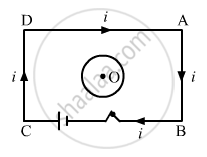
Energy dissipate in LCR circuit in
Lenz's law gives ______
There are two coils A and B as shown in figure. A current starts flowing in B as shown, when A is moved towards B and stops when A stops moving. The current in A is counterclockwise. B is kept stationary when A moves. We can infer that ______.

Same as problem 4 except the coil A is made to rotate about a vertical axis (figure). No current flows in B if A is at rest. The current in coil A, when the current in B (at t = 0) is counterclockwise and the coil A is as shown at this instant, t = 0, is ______.

Consider a metal ring kept on top of a fixed solenoid (say on a carboard) (Figure). The centre of the ring coincides with the axis of the solenoid. If the current is suddenly switched on, the metal ring jumps up. Explain
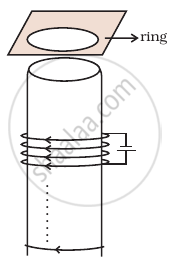
Predict the direction of induced current in the situation described by the following figure.
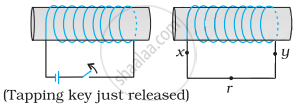
Use Lenz’s law to determine the direction of induced current in the situation described by the figure.
A circular loop being deformed into a narrow straight wire.
